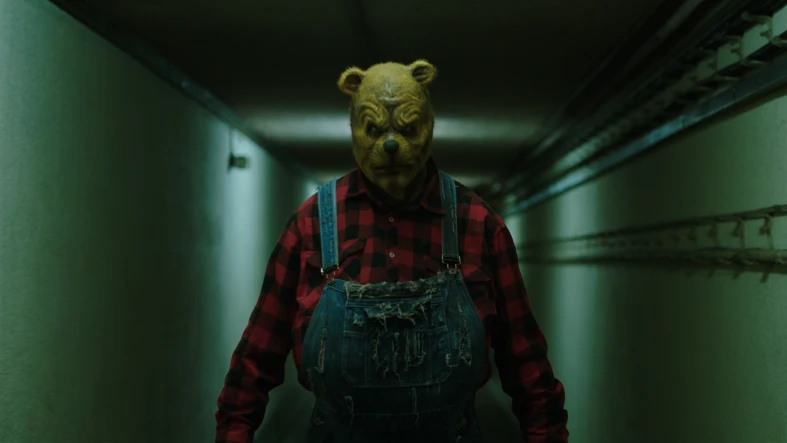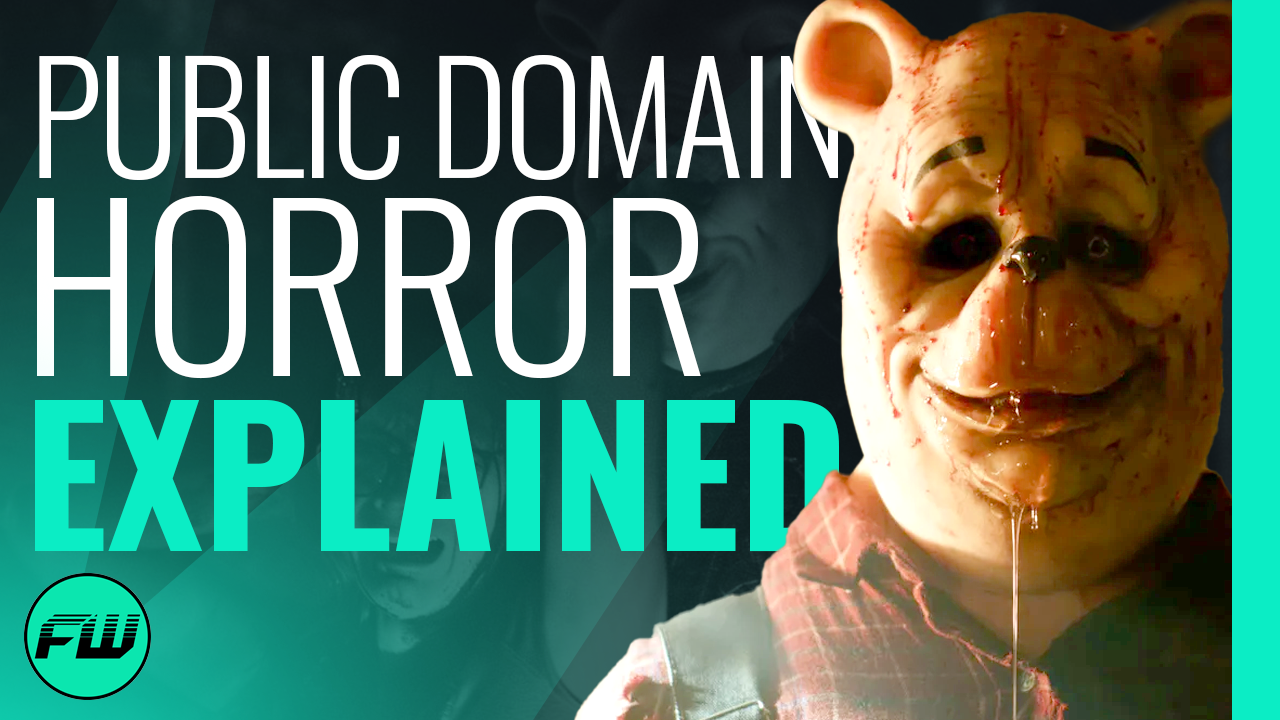In this FandomWire Video Essay, we explore the CURSE of the Public Domain.
Check out the video below:
Subscribe & hit the Notification Bell so you never miss a video!
Public Domain Explained

This is nightmare fuel — not just for children but also for one of the biggest corporations in the world. And there’s one thing that is allowing these horror movies using well-known characters to be created: the public domain.
The public domain is the term used to refer to the vast body of works on which copyright has expired. Since the original copyright owner no longer has exclusive rights to their creation, any artist can now use these ideas to create their own work.
The public domain exists primarily for the purpose of cultural preservation. Thanks to the public domain, works from generations past can be made freely accessible to the scholars and creators of today and the future, ensuring that our cultural output remains as rich as possible for the foreseeable future. Thanks to the public domain, writers, filmmakers, and artists of all kinds have been able to interpret classic and age-old stories in essential ways.
There have been numerous positive uses of the public domain. Think of all the modernizations of classic Shakespeare stories — be they direct adaptations or simply other stories that use Shakespeare’s tales as inspiration. Without the public domain, many of your favorite movies wouldn’t exist.
Yet, as happens all too often, people are abusing the public domain in harmful ways — for both the creators and the public at large. Many filmmakers have begun to release horror movies using characters from classic childhood tales, and while these might be “allowed,” that doesn’t mean they’re a good thing.
One of the most notorious examples of this is Winnie-the-Pooh: Blood and Honey, the British horror film directed by Rhys Frake-Waterfield, which boasts an abysmal 3% critics score on Rotten Tomatoes and a rating of 16 on Metacritic. Reviews condemned the film for its low budget, bastardization of its source material, and poor storytelling.
Movies like Winnie-the-Pooh: Blood and Honey are made for little reason other than to shock the audience. They take these characters people cherish from their childhood and use them in a way that is overtly and intentionally disgusting. Although they have their fans who are interested in the sadism of seeing innocence lost, most audiences reject these films for their lack of creativity.
However, it becomes tricky because the characters are in the public domain only as created by A. A. Milne. The versions of the characters audiences are most familiar with seeing are still copyrighted by Disney. That’s why you won’t see Winnie going around without pants in a red shirt in any of these “public domain horror” movies, nor will you see the characters resembling their cute counterparts in the animated films. Filmmakers like Frake-Waterfield must offer a completely different visual interpretation of these characters.
Another term that people often confuse with the public domain is fair use. Fair use is a legal defense that allows artists to use elements of copyrighted works under specific pretenses, such as criticism, parody, or education. This doesn’t mean filmmakers won’t be sued by the person or corporation that holds the copyright — and in many cases, like some NSFW parodies, they could lose.
The spoof is the best example of a type of work protected by fair use. Comedies like Scary Movie are covered under fair use because they ridicule the original idea — not directly copying them. So, how do horror movies using these characters not fall under the fair use defense?
The main factor is the length of the content used. Spoofs tend to contain elements from many different films they parody, while these horror movies based on public domain characters are solely focused on a single work. This is why many filmmakers have taken the opportunity of these stories entering the public domain to bring their demented visions to life.
However, while the Winnie-the-Pooh horror movie only tangentially relates to Disney’s IP, since Disney’s films were an adaptation in and of themselves, Disney has an even bigger public domain headache on their hands: Mickey Mouse.
On January 1, 2024, the original short film that created Mickey Mouse — Steamboat Willie — entered the public domain. Considering how quickly we got a horror movie when Winnie-the-Pooh entered the public domain, it should be no surprise that a slew of Mickey horror movies were announced that day.
Obviously, Disney does not want the character most closely identified with their brand’s identity to be featured in a horror film. Although these movies are not made for kids, could you imagine if a child accidentally came across a movie where Mickey Mouse is doing scary things? They would be traumatized and never want to go to Disney’s theme parks again.
For Disney, the public domain has been public enemy number one for years now. Of course, the House of the Mouse didn’t want their signature IPs being diluted by uses from unapproved sources. The original US copyright laws passed in 1928 protected works for 56 years from their creation, but before the copyright for Mickey Mouse was set to expire in 1983, Disney lobbied Congress to pass reform that protected copyright for 50 years after the author’s death.
Under this legislation, the copyright for Mickey Mouse would have entered the public domain in 2003. As we all know, that didn’t happen, as more reform was passed in 1997 that extended the copyright once again. Only in 2024 did the copyright for the original Mickey Mouse short Steamboat Willie enter the public domain, allowing creative minds to do their bidding with the crown jewel of Disney’s creations.
However, it’s important to note that the only version of the famed rodent that entered the public domain was the original version. Later versions of Mickey Mouse are still copyrighted until those works reach the end of their protected period. If an artist wants to use the character, they have to use the original version as seen in 1928 — or at least make variations on it. If an artist’s version looks similar to the character’s later versions, they could find themselves facing legal trouble.
The law is also clear that works created using the characters in the public domain must not mislead customers into thinking that their work is created or endorsed by Disney. In film, the easiest way to ensure compliance with this guideline is for an artist to clearly identify the company that produced the work in the credits. However, it’s not so cut-and-dry when it comes to other mediums.
For example, it’s essential to understand that the Mickey Mouse character is so closely entwined with the Disney brand that the company could have a trademark claim for certain uses. For example, using the Mickey Mouse character on apparel could be problematic because it could confuse consumers into thinking it is officially licensed merchandise.
It’s understandable why Disney would want to protect its creation. Disney is one of the biggest companies in the entertainment business, and Mickey Mouse is a fundamental part of its image. However, in many ways, the company’s approach to copyright and allowing its works to enter the public domain is incredibly hypocritical.
Many of Disney’s most iconic works are not original creations but are based on public domain works themselves. Your favorite Disney classic is probably based on a public domain story: Cinderella, Aladdin, The Jungle Book, The Little Mermaid, Frozen, Beauty and the Beast, The Lion King, Alice in Wonderland, and plenty more. If it weren’t for the public domain, Disney might not be the pop culture zenith it is today.
Yet it doesn’t seem like the uses of Disney’s characters that are now in the public domain will be as creative or influential as the work Disney has done itself using the public domain. Although movies like Winnie-the-Pooh: Blood and Honey will indeed have their fans, these “public domain horror movies” seem to exist for little purpose beyond their shock value.
Instead, what we should hope to see in the entertainment industry is the use of characters in the public domain for unique visions. These characters can now be used as a source of inspiration and creativity.
In many ways, the recent uses of public domain characters feel lazy. These filmmakers are taking bad storytelling and slapping popular characters onto them to create a forced sort of “originality” — and it’s not working.
The public domain is undoubtedly a valuable part of our cultural production, but we need to return to the uses of these works that are meaningful and unique, not spineless and uninteresting. Movies like Winnie-the-Pooh: Blood and Honey unfairly give the public domain a bad name.
What do you think? Do you want to see more horror movies based on public domain characters like Winnie-the-Pooh: Blood and Honey? Or would you rather filmmakers and artists avoid public domain characters altogether? Be sure to let us know in the comments below, and don’t forget to like and subscribe. As always, thanks for watching! Until next time!
Follow us for more entertainment coverage on Facebook, Twitter, Instagram, and YouTube.

